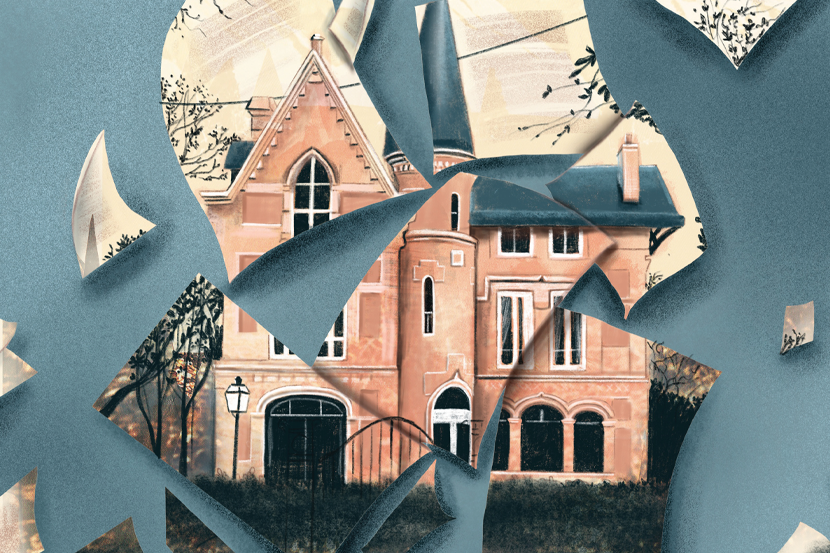
Fictional houses often capture the imagination just as much as the characters that inhabit them – and in some cases, they steal the show. Discover the secrets behind crafting these unforgettable abodes and the real-life inspirations that brought them to life.
Stone pillars guard the entrance. You push open the ivy-tangled gate and walk along the weed-choked lawn that encircles a disused fountain. Climbing the cracked flagstone steps, you see that the front door ahead is open. Inside the large hallway, you take in your surroundings, a row of closed doors that hint at treasures within. From behind one, you hear a whispered conversation. Behind another, smashing glass and raised voices. From the staircase above comes a laugh, swiftly stifled. A floorboard beneath your feet is loose. This house is not real, however. It’s constructed of paper and ink, and all you have to do to discover its secrets is turn the page.
Houses in novels hold a fascination for readers – and an attraction for writers – that’s unmatched by other settings. From ancestral mansions to cosy cabins, there’s something about fictional dwellings that invites us to step inside and settle in. But what makes some so memorable? What inspires novelists to construct these imaginary places? And is there a particular type that most appeals, or will readers eagerly consume any well-written story simply to reside within its four imaginary walls?
Creating fictional houses that capture the imagination
Top tips for creating an impactful abode:
Include plenty of rooms
‘In an open space, you can’t have canoodling behind the palms,’ says Phyllis. ‘A memorable house needs spaces for things to happen – rooms for mystery and secrets.’ However, perhaps there’s also drama to be created when, like a stage set, no argument can be left unheard and there’s no place to hide.
Imbue those rooms with feeling
It’s not enough to describe the rooms, they also need a touch of atmosphere. ‘Ascribe meaning,’ suggests Phyllis. ‘Make the reader feel invested in the rooms.’ For example, what significance does the bird wallpaper hold in the first-floor back bedroom? And why is a once-loved grand piano now covered in a thick layer of dust?
Don’t make it too comfortable
There might be feather beds and tea on the terrace at four o’clock, but with no friction, there’s no story. Emotional tension should crackle between the inhabitants, with family discord reflected in the rooms in which they play out. And for those who prefer a darker turn, fictional dwellings have a long history of haunted corridors and shadowy attics where things tend to go bump in the night.
Have fun
‘Imagining ourselves in someone else’s house is a way of trying on their life for size,’ says Ruth. Enjoy living inside your invented space of decadence or decay – become your own architect, and go wild on interiors, without the expense.
The real homes behind famous fictional houses
Chance upon the bricks and mortar behind the fiction
Menabilly, Cornwall
In the late 1920s, a young woman with a vivid imagination came across an abandoned mansion named Menabilly, in the woods near her family’s Cornish summer home. It’s all crumbling grandeur, moss in the windows, and mouse droppings on the damask. But for author Daphne du Maurier, the house is all potential. She’ll spend the next 20 years hankering to live there, and when she does, will use it as the setting for three of her novels, most famously – renamed Manderley – in Rebecca. The house is still privately owned and not open to visitors.
Woodlands (Inglewood), Killara
During her time at Woodlands (known as Inglewood in the early 1890s), residing with her stepfather Charles Cope, mother Sarah, sisters Lilian and Rose, and brother Rex, Ethel Turner penned the wildly popular Seven Little Australians and The Family at Misrule. The bushland domestic setting of the classic Georgian-styled two-storey villa provided inspiration for Turner’s novels.
Greenway House, Devon
The late-Georgian, white-stuccoed walls of Greenway, whose lawns tumble down to the river Dart, near the south Devon coast, was the author Agatha Christie’s holiday home – ‘a dream house,’ as she described it. The house and grounds became the setting for several fictional murders, including Five Little Pigs and Dead Man’s Folly.
The Manor, Cambridgeshire
As Green Knowe in Lucy M Boston’s children’s books, this is Ruth Ware’s favourite fictional house. ‘I’ve loved it since childhood,’ she says. ‘I think it’s no accident that the house’s name is in the title of the book – the house is the real star.’ These tales of ghosts and magic are based on Boston’s real-life home, The Manor, in Hemingford Grey, Cambridgeshire. Its interiors date from the 12th century, with metre-thick stone walls and just as much atmosphere. ‘I’ve longed to visit for years,’ says Ruth. ‘But part of me has never quite dared in case it doesn’t live up to the magic of my imagined version!’


















